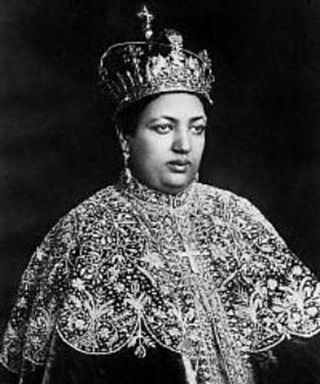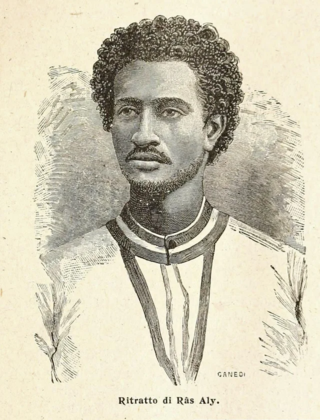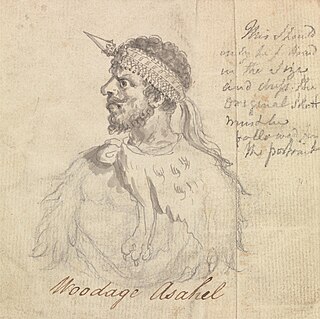
Antoine Thomson d'Abbadie d'Arrast was an Irish-born French explorer, geographer, ethnologist, linguist and astronomer notable for his travels in Ethiopia during the first half of the 19th century. He was the older brother of Arnaud-Michel d'Abbadie, with whom he travelled.

Lij Iyasu was the designated Emperor of Ethiopia from 1913 to 1916. His baptismal name was Kifle Yaqob. Ethiopian emperors traditionally chose their regnal name on the day they were crowned, and since he was never crowned, he is usually referred to as Lij Iyasu, "Lij" meaning child, especially one born of royal blood.

Tewodros II was Emperor of Ethiopia from 1855 until his death in 1868. His rule is often placed as the beginning of modern Ethiopia and brought an end to the decentralized Zemene Mesafint.

Menen Asfaw was Empress of Ethiopia as the wife of Emperor Haile Selassie.

Arnaud-Michel d'Abbadie d'Arrast, listed in the Chambers Biographical Dictionary as Michel Arnaud d'Abbadie was an Irish-born French and Basque explorer, best known for his travels in Ethiopia with his elder brother Antoine d'Abbadie d'Arrast. Arnaud was a geographer, ethnologist, linguist, familiar with the Abyssinian polemarch and an active witness to their battles and the life of their courts. The general account of the two brothers' travels was published by Arnaud in 1868 under the title Douze ans de séjour dans la Haute-Ethiopie.

Tekle Giyorgis II was Emperor of Ethiopia from 1868 to 1871. After being crowned, he linked himself to the last independent emperors of the Gondar line through his mother and sought support from the Ethiopian Church to strengthen his right to rule. He was wounded when fighting during the 1871 Battle of Adwa, leading to the demoralization of his troops and capture of him and his generals and later on his death in captivity.
Sahle Dengel was Emperor of Ethiopia intermittently between 1832 and 11 February 1855, towards the end of the Zemene Mesafint. He was largely a figurehead, with real power in the hands of Ras Ali II of Yejju.

Ali II of Yejju was Ras of Begemder and the de facto ruler of the Ethiopian Empire. He was a member of a powerful Welo dynasty known as the Yejju, which ruled much of the Ethiopian Empire during the Zemene Mesafint.

The Battle of Segale was a civil conflict in the Ethiopian Empire between the supporters of Empress regent Zewditu and Lij Iyasu on 27 October 1916, and resulted in victory for Zewditu. Paul B. Henze states that "Segale was Ethiopia's greatest battle since Adwa" (1896).
The Battle of Debre Tabor was a conflict during the Zemene Mesafint in 1842 initiated by Dejazmach Wube Haile Maryam to overthrow Ras Ali II as Regent of the Emperor of Ethiopia and gain control of Ethiopia. This confused battle was won by Ras Ali, but at a steep price, and this victory failed to cement his position as the most powerful nobleman of his time.
The Battle of Amba Jebelli was fought in Ethiopia in 1854 between the forces of Kassa Hailu, and the forces of Birru Goshu of Gojjam. Kassa was victorious, Birru Goshu was captured and spent the next 14 years in chains.

RasDesta Damtew KBE was an Ethiopian noble, army commander and a son-in-law of Emperor Haile Selassie I. He is known for his leadership in the Ethiopian Army during the Second Italo-Ethiopian War. He was executed on 24 February 1937, by the Italian Armed Forces shortly after Ethiopia's loss in the war.

RasMulugeta Yeggazu was an Ethiopian government official, who served in the first cabinet formed by Emperor Menelik II. He served as Imperial Fitawrari, Commander of the Mahel Sefari of the Ethiopian Army during the Second Italo-Ethiopian War.
The Battle of Anchem was fought between two factions of the Royal family in the Ethiopian Empire. The battle was fought to determine who would rule the empire, Empress Zewditu or King (Negus) Tafari Makonnen.

The Yejju Oromo, also historically known as the Yajju, Edjow or Edjou Galla, are a sub-clan of the Barento branch of Oromo people. They are one of the northernmost communities of Oromo people residing in Ethiopia, along with the Raayyaa.
Dima is a village in west-central Ethiopia. Located in the Misraq Gojjam Zone of the Amhara Region, it has a latitude and longitude of 10°0′N38°29′E and an elevation of 2076 meters above sea level. It is one of three settlements in Enemay woreda.
Dejazmach Birru Aligaz was a nobleman of 19th century Ethiopia during the Zemene Mesafint. As Dejazmach, he held the governorships of different districts such as Lasta and Dembiya and was made governor of Dawunt, Wollo in 1842 by Ras Ali II of Yejju. He was the son of Ras Aligaz Abba Seru Gwangul, and had a son called Dejazmach Zegeye.

Wube Haile Maryam of Semien,, also called by his title Dejazmach Wube, Webé; his name is also given in European sources as ‘‘Ubie’’, was one of the major figures of 19th century Ethiopia, during the closing decades of the Zemene Mesafint a period of regional lords vying for power, prestige and territory amid a weakened authority of the emperors.
Goshu Zewde of Gojjam, also known by his horse name Abba Kanno, was a prominent governor of Damot, Metcha, and Ybaba during the first half of the 19th century. While his son Birru Goshu governed most of Gojjam, Goshu’s influence extended widely, solidifying his reputation as a formidable leader. As a member of the ruling dynasty of Gojjam, he was one of the significant lords in the last decades of the Zemene Mesafint. Respected by princes, church leaders, and farmers alike, Goshu was admired for his noble lineage and his admirable character. His influence and dedication were further recognized when he was granted the title of Dejazmach in 1825 and elevated to Ras by Emperor Sahle Dengel in 1848.
Dejazmach Birru Goshu (1814-1869) of Gojjam was a significant Ethiopian noble who held considerable sway over the political landscape of Ethiopia during the latter period of the Zemene Mesafint, a time of intense regional competition among ruling dynasties. According to the British diplomat Walter Plowden, Birru Goshu was "the most remarkable man in Abyssinia" before the rise of Tewodros II.











